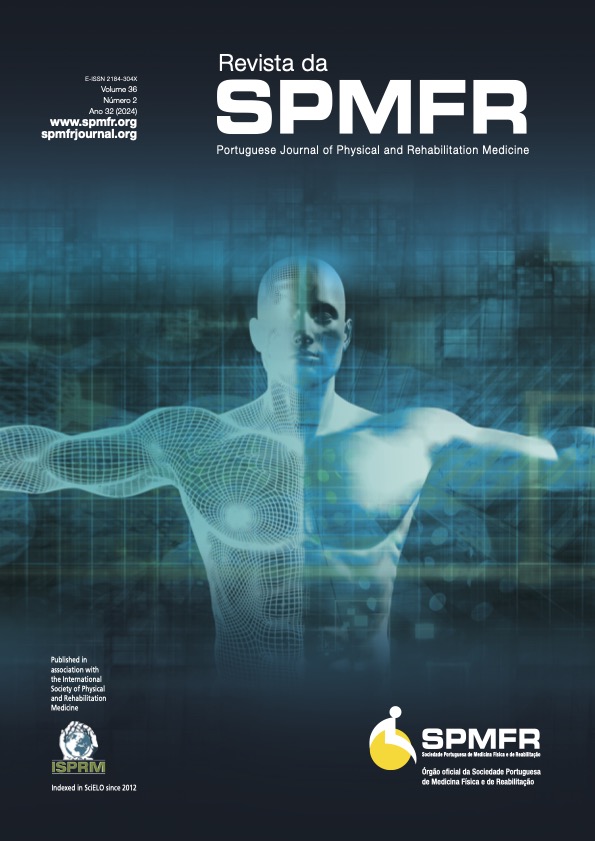Hirayama Disease: Report of a Successful Clinical Case
DOI:
https://doi.org/10.25759/spmfr.501Keywords:
Adolescent, Muscle Weakness, Spinal Muscular Atrophies of Childhood/rehabilitationAbstract
The authors present a case of Hirayama’s disease in a 17- year-old boy who had been complaining, for a year and a half, of pain and unilateral motor deficits in the 4th and 5th fingers of the right hand with progressive functional impairment. On examination, atrophy of the ulnar anterior aspect of the forearm, and right thenar and hypothenar regions was evident, associated with a deficit of muscle strength in the distal segments of the right upper limb. Contrast-enhanced cervical magnetic resonance was performed in the neck flexion position, which showed dynamic changes suggestive of Hirayama’s disease. Electromyography showed extensive bilateral segmental neurogenic damage, with a right predominance, between C6 and T1. Motor nerve conduction studies showed a decrease in the amplitude of the C8-T1 myotomes. The patient started daily use of a soft cervical collar to prevent cervical flexion and a multimodal rehabilitation program with physiotherapy and occupational therapy with significant clinical and functional improvement over 10 years of evolution. A brief and contextualized review of the literature is made, framing it with the patient’s clinical evolution.Downloads
References
Hirayama K, Tomonaga M, Kitano K, Yamada T, Kojima S, Arai K. Focal cervical poliopathy causing juvenile muscular atrophy of distal upper extremity: a pathological study. J Neurol Neurosurg Psychiatry. 1987;50:285-90. doi: 10.1136/jnnp.50.3.285.
WangH,TianY,WuJ,LuoS,ZhengC,SunC,etal.Updateonthe Pathogenesis, Clinical Diagnosis, and Treatment of Hirayama Disease. Front Neurol. 2022;12:811943. doi: 10.3389/fneur.2021.811943.
Zhou B, Chen L, Fan D, Zhou D. Clinical features of Hirayama disease in mainland China. Amyotroph Lateral Scler. 2010;11:133-9. doi: 10.3109/17482960902912407.
Hassan KM, Sahni H, Jha A. Clinical and radiological profile of Hirayama disease: A flexion myelopathy due to tight cervical dural canal amenable to collar therapy. Ann Indian Acad Neurol. 2012;15:106-12. doi: 10.4103/0972-2327.94993.
Shao M, Yin J, Lu F, Zheng C, Wang H, Jiang J. The Quantitative Assessment of Imaging Features for the Study of Hirayama Disease Progression. Biomed Res Int. 2015;2015:803148. doi: 10.1155/2015/803148.
Li Y, Remmel K. A case of monomelic amyotrophy of the upper limb: MRI findings and the implication on its pathogenesis. J Clin Neuromuscul Dis. 2012;13:234-9. doi: 10.1097/CND.0b013e3182461afc.
Huang YL, Chen CJ. Hirayama disease. Neuroimaging Clin N Am. 2011;21:939-50, ix-x. doi: 10.1016/j.nic.2011.07.009.
Pradhan S. Bilaterally symmetric form of Hirayama disease. Neurology. 2009;72:2083–9. doi: 10.1212/WNL.0b013e3181aa5364.
Foster E, Tsang BK, Kam A, Storey E, Day B, Hill A. Hirayama disease. J Clin Neurosci. 2015;22:951-4. doi: 10.1016/j.jocn.2014.11.025.
WangH,ZhengC,JinX,LyuF, MaX,XiaX,etal.TheHuashandiagnostic criteria and clinical classification of Hirayama disease. Chinese J Orthop. 2019:12;458-65.
Lin MS, Kung WM, Chiu WT, Lyu RK, Chen CJ, Chen TY. Hirayama disease. J Neurosurg Spine. 2010;12:629-34. doi: 10.3171/2009.12.SPINE09431.
Bohara S, Garg K, Mishra S, Tandon V, Chandra PS, Kale SS. Impact of various cervical surgical interventions in patients with Hirayama's disease-a narrative review and meta-analysis. Neurosurg Rev. 2021;44:3229-47. doi: 10.1007/s10143-021-01540-2.
Tashiro K, Kikuchi S, Itoyama Y, Tokumaru Y, Sobue G, Mukai E, et al. Nationwide survey of juvenile muscular atrophy of distal upper extremity (Hirayama disease) in Japan. Amyotroph Lateral Scler. 2006;7:38-45. doi: 10.1080/14660820500396877.
Fujimori T, Tamura A, Miwa T, Iwasaki M, Oda T. Severe cervical flexion myelopathy with long tract signs: a case report and a review of literature. Spinal Cord Ser Cases. 2017;3:17016. doi: 10.1038/scsandc.2017.16.
Downloads
Published
How to Cite
Issue
Section
License
Copyright (c) 2024 Revista da Sociedade Portuguesa de Medicina Física e de Reabilitação

This work is licensed under a Creative Commons Attribution-NonCommercial-NoDerivatives 4.0 International License.
Copyright statement
Authors must also submit a copyright statement (as seen below) on article submission.
To the Editor-in-chief of the SPMFR Journal:
The below signed author(s) hereby state that the article
________________________________________ (ref. MFR_________) is
an original unpublished work and all facts stated are a product of the author(s) investigation. This article does not violate any copyright laws or privacy statements. The author(s) also hereby confirm that there is no conflict of interest's issues in this article.
By submitting this article the author(s) agree that after publication all copyrights belong to the SPMFR Journal.
Signed by all authors
Date:
Names (capital letters):
Signatures:
The SPMFR Journal’s contents are follow a Creative Commons licence. After publication the authors can hand out the articles as long as the SPMFR Journal is credited.



